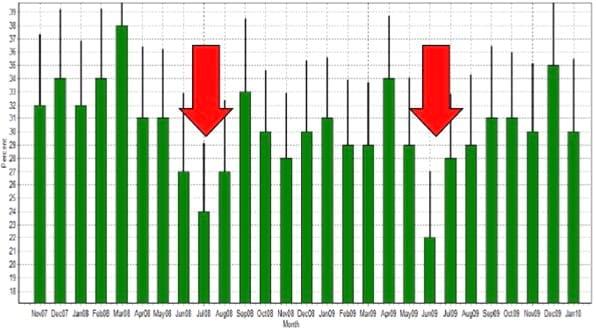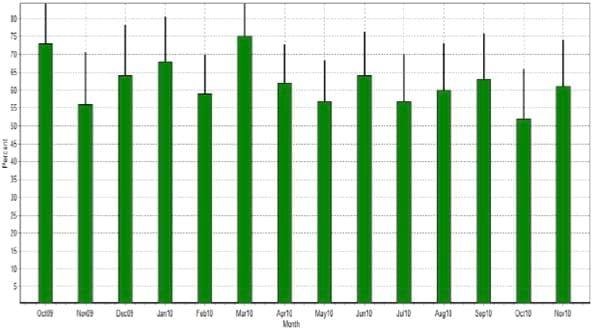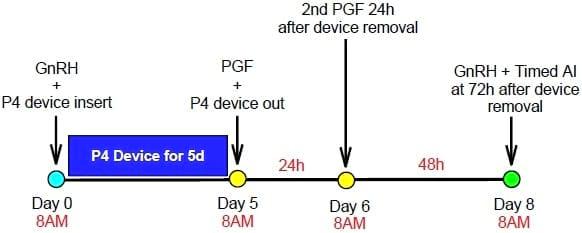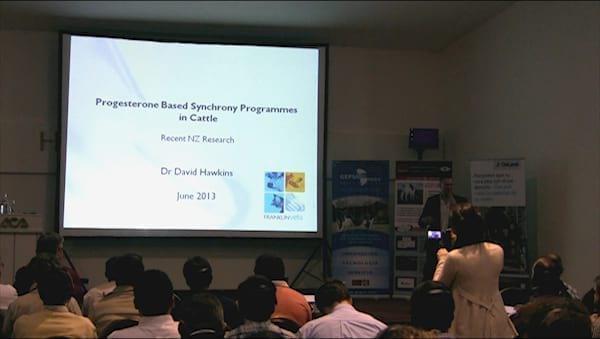Synchronization programs in dairy heifers: push the gas pedal when needed!
Published: March 7, 2014
By: Alex Souza (Dairy Advisor at University of California)
Reproduction performance in lactating dairy cows is frequently not ideal and tends to fluctuate throughout the year due to many different factors, but particularly heat stress. In herds in which cows undergo sustained heat stress periods, the number of pregnancies that can be generated in the lactating animals in a weekly basis is dramatically reduced during warmer months. The figure below represents the fluctuation in conception in a large dairy herd in Wisconsin-USA (Fig 1). Notice the marked decrease in conception results of the lactating cows during summer months even in a dairy herd located in Wisconsin. This cyclic reduction in conception in the lactating herd is even more dramatic in herds in southern USA and Mexico, or even in more extreme areas such as the Middle East.
Obviously many strategies can be implemented to try to reduce the impact of heat stress in the lactating herd including cooling systems, shade and water availability, changes in diet composition, use of embryo transfer, etc. However, even after adopting some of these management strategies to combat heat stress, fertility might still be significantly reduced in summer months. As an inevitable result a large fluctuation in number of pregnancies generated per week or month. The time scale when it comes to analyzing variation throughout the time herd size matters! So large herds might benefit from identifying fluctuations in conception obviously sooner than smaller herds – it will take time for smaller herds to build up enough numbers to see clear trends in the dataset.

Fig 1. Fluctuation in conception throughout the year in lactating cows in a large dairy “herd A” undergoing heat stress in summer months (dairy herd based inWisconsin-USA, which is not even close to be considered a state under extreme heat stress conditions such as in Southern US or Mexico).
A successful strategy used by dairy herds in the Middle East for instance is to try to compensate the fewer number of pregnancies generated in the lactating herd by inseminating more heifers in those weeks and “catch up” the number of pregnancies needed for that week or month. This can be done mostly because conception performance in non-lactating heifers is fairly stable throughout the year as shown in Figure 2 below. One thing to keep in mind is that the farmer need to get prepared to have more heifers calving in summer months and perhaps implement management strategies to minimize stocking rate issues and competition between older and first lactation heifers in the transition and fresh pens. Conception at first AI in heifers calving in summer will most likely be lower than heifers calving in cooler seasons of the year, but perhaps 1st AI can be delayed in heifers calving during summer months due to the greater lactation persistence in primiparous cows.

Fig 2. Conception rate in non-lactating heifers for the same “herd A” based in WI-USA. Conception results in virgin heifers are less affected during warmer months, and will be nearly or above 60% throughout the year.
Thus, it is reasonable to think that reproduction efficiency in heifers should be able to compensate - at some extent - the flaws in reproduction in the lactating herd particularly during summer months and especially in modern herds running at up to 40% culling rates/year.
Another piece to the puzzle of trying to manage a large dairy herd is related to keeping stocking rates under control in the breeding pen, and the numbers of heifers coming “in” and “out” of the breeding pen will vary if the numbers of pregnancies generated throughout the year are too variable in the herd as a whole (lactating + non-lactating heifer pregnancies). Therefore, at times producers will need to speed-up and get more heifers “out” of the breeding pen but some of these older heifers might be not pregnant yet. The contrary is also true, sometimes producers will need to move proportionally more heifers “in” the breeding pen to relief stocking rates in the previous pen. Therefore, producers might need to have a better handle on the “speed” of getting heifers pregnant at set times. Heifer growers will probably have more issues to maintain steady numbers of heifers in the breeding pens due to the fact they are dealing with heifers from several herds and different management conditions.
Another piece to the puzzle of trying to manage a large dairy herd is related to keeping stocking rates under control in the breeding pen, and the numbers of heifers coming “in” and “out” of the breeding pen will vary if the numbers of pregnancies generated throughout the year are too variable in the herd as a whole (lactating + non-lactating heifer pregnancies). Therefore, at times producers will need to speed-up and get more heifers “out” of the breeding pen but some of these older heifers might be not pregnant yet. The contrary is also true, sometimes producers will need to move proportionally more heifers “in” the breeding pen to relief stocking rates in the previous pen. Therefore, producers might need to have a better handle on the “speed” of getting heifers pregnant at set times. Heifer growers will probably have more issues to maintain steady numbers of heifers in the breeding pens due to the fact they are dealing with heifers from several herds and different management conditions.

Synch programs will allow producers to speed-up the number of pregnancies in the heifer pen within one week when needed – its ease to push the gas pedal in terms of producing pregnancies by using synchronization programs in the heifer pen. Thus, even when a good tail-chalk system is in place, synchronization programs might be fairly helpful to producers trying to control a bit better the speed in which heifers are getting pregnant: 1) to compensate the poor fertility of the lactating herd in summer months; and 2) to push heifers “in” and “out” of the breeding pen.
Yet, a third use of synch programs in heifers might be related to the use of sexed semen when the market situation allows. Regardless of the economics of the use of sexed semen, its greater price, relatively lower conception when compared to regular semen, etc expansion projects seem to benefit from an “in-house” production of replacement heifers, mostly due to biosecurity issues.
For example, synch programs can be used at 1st AI to produce some more female-pregnancies in virgin heifers, and these same heifers can be bred in returning estruses on time with regular semen in this is the case, so they are not overwhelmingly old at calving time. The decision to use sexed semen is market sensitive and a tool developed at the University of Wisconsin (go to “Reproduction” tab) might come handy when it comes to “how much, if any” sexed semen should be used in a group of heifers.
http://dairymgt.uwex.edu/tools.php
Question: roughly how many pregnancies can I produce within 30 days in a group of 100 heifers at breeding age? A) Only by using outstanding estrus detection routines at 65% efficiency; or B) Synch program + estrus detection. Assuming that 100% of heifers are cycling just fine, this is rarely the case though in real herds, here is how the speed of pregnancy would look like:
This type of pattern has been reported by several research groups and obviously the speed in estrus expression and proportion of pregnant heifers can be improved quite a bit when using 14d or even 7d PGF2α treatment intervals to synchronize estrus. Keep in mind that PGF will fail to induce luteolysis (CL regression) in about 1/3 of the cycling heifers, and will not have a marked effect in anestrus heifers. Regardless of that, at the end of the day you can move “in” or “out” heifers from breeding pen a lot faster when synchronizing the breeding with a decent timed AI protocol in heifers. For instance, in our example above, about 50% of the heifers in the timed AI group could be moved-up to pregnant heifer pens, leaving more room for more heifers in the breeding pen sooner. In addition, these heifers would later calve roughly ~20 days sooner. I’m not an economist, but just feed expenses alone in a group of 50 heifers for 20 days should be more than enough to pay for the hormones used in the synchronization program on those heifers, not to mention the extra income from earlier milk production in heifers calving earlier – they would start paying their bills sooner. In addition, heifers that would otherwise be too old and fat, having more metabolic issues would stand a chance to conceive sooner and get around metabolic issues a bit better after freshening.

Fig 3. Estimated accumulated pregnancies in heifers managed with synch programs + estrus detection (continuous line) in returning estruses or only bred following natural estrus (dotted line).
OK, let’s assume you’re convinced about using a synch program…the issue now is which one? There are about 100 variations of synch programs if not more…but in fact just a few seem to produce reasonable results in non-lactating heifers.
Briefly, in countries in which estradiol is not available, the short progesterone programs such as the 5d-progesterone has been shown to produce conception results that are comparable to breeding after natural occurring estruses. This is a big deal, since previous synchronization programs available in US for instance did not seem to perform very well in non-lactating heifers. There are still a few variations in the 5d-protocol that may be used to adapt the synch program to most management routines. Following, I have attached the variation of the 5d protocol giving the highest results in terms of conception – might be a bit laborious for some herds to follow through, and more simple variations may have to be considered in some cases. Obviously, the most complete program seem to produce enhanced (~5 to 10% points) conception results as compared to the most simple variation. Difference in costs between the two protocols is in fact minimal and farmers and consultants should prefer to look at cost-per-pregnancy and not the straight cost of the protocol.

Other protocols using estrogens and progesterone to synchronize the emergence of the follicular waves also seem to produce satisfactory results in heifers that are comparable to the 5-d progesterone protocol. Normally, in these types of protocols eCG (equine gonadotropin) seem to improve conception results when given at P4 device removal. This is particularly truth in zebu/crosses.
All together, regardless of the country and hormones available, there are plenty of good synch programs that produce outstanding conception results. This should be considered by dairy producers as an available tool to be used strategically in his reproductive routine.
References are available upon request – don’t hesitate to get in contact for further details on the subject.
This paper was presented at the 12º Congreso Internacional de MVZ especialistas en Bovinos de la Comarca Lagunera, Mexico, November 2012.
Related topics:
Authors:
UC Davis - University of California
Recommend
Comment
Share
Recommend
Reply

Would you like to discuss another topic? Create a new post to engage with experts in the community.






